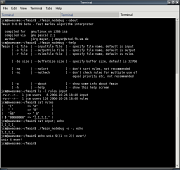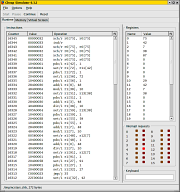json comment stripper

|
A minimal JSON comment stripper written in Groovy. Eats up all comments a given JSON file brings along. Won't change line or column numbers. The archive also contains a small GraphML file visualizing the underlying state machine. |
fast markov algorithm interpreter (fmain)
- • view highlighted source
- • download linux binary tarball
- • download win32 binary zip archive
- • download source tarball
educational markov algorithm interpreter (emain)
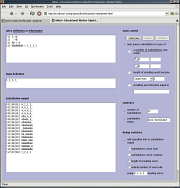
|
While the fmain described above is optimized on speed this tool is meant to be used in education and for debugging markov rules. For these puposes the emain got an easy to use gui where the user is able to input character data and rules in visible text fields. Furthermore there are buttons and switches to start, pause or control the appliance of rules in many ways. You may want to browse the directory listing to have a look at some sample text files. The program isn't compiled for a special hardware or system. All it needs to run emain is a modern web browser capable of latest html and some javascript. Any version of Mozilla should do fine. It also works with any newer Internet Exploder or Konqueror. |
post calculus interpreter (pocain)
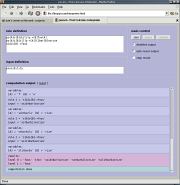
|
Similar to the emain above this litte tool comes along with an easy to use interface. As anybody can guess from the name it works as an interpreter for post calculus rules. The user is able to switch between two different output modes in combination with a special step mode as a further help in your crazy debugging sessions. You may want to browse the directory listing to have a look at some sample text files. The program isn't compiled for a special hardware or system. Any modern web browser can be used as a runtime environment. Firefox and Konqueror have been tested and work just fine. You should avoid Internet Exploder 6 or below when possible for it has problems rendering the output and the step mode behavior seems frelled too. |
puzzle solver
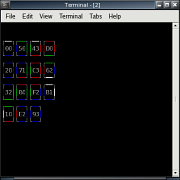
|
The screen shot of this program might not look too spectacular. Nevertheless believe me, the whole thing was more difficult to code as most people - including myself - think at first thought. Remaining people will say: Yes, of course it can't be that simple, as you have to use three level backtracking to kill that beast. You can find some more lines speaking about idea and functionality of the puzzle solver by reading in the gallery section. Just like the fmain on top of the page this program was also written in Pascal. To build the binary you will need the gpc and also an ncurses-devel package installed on your system. |
